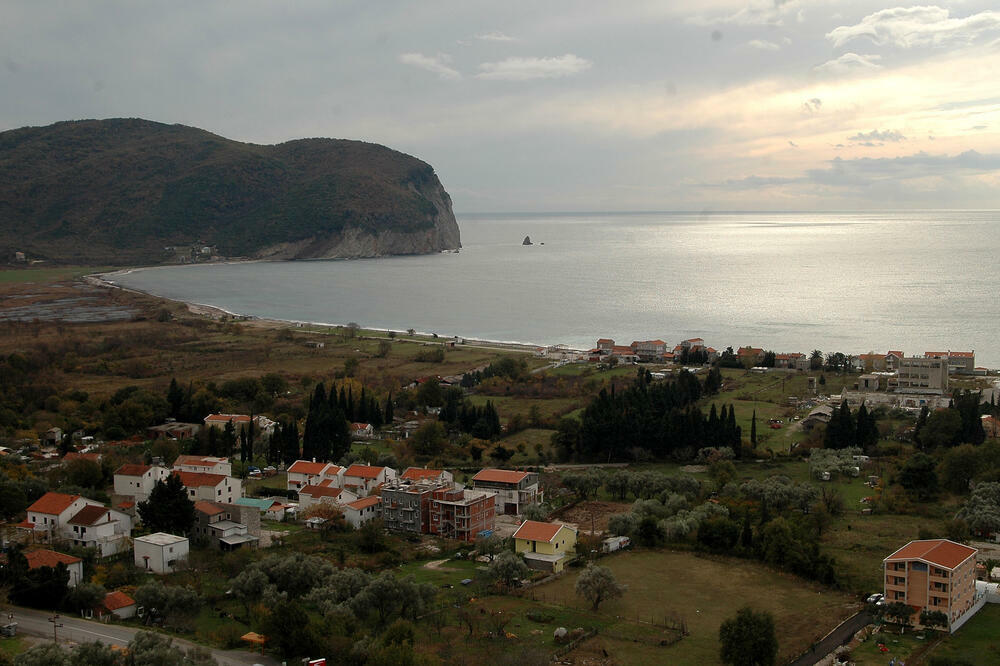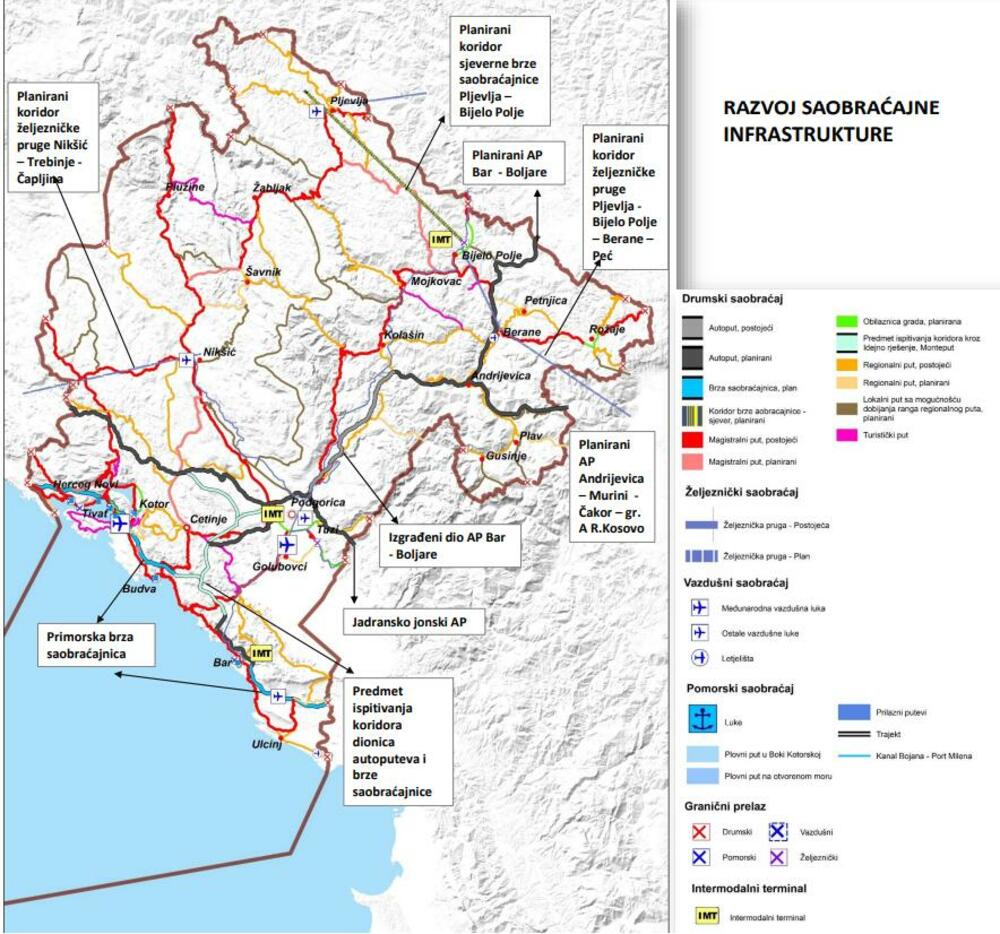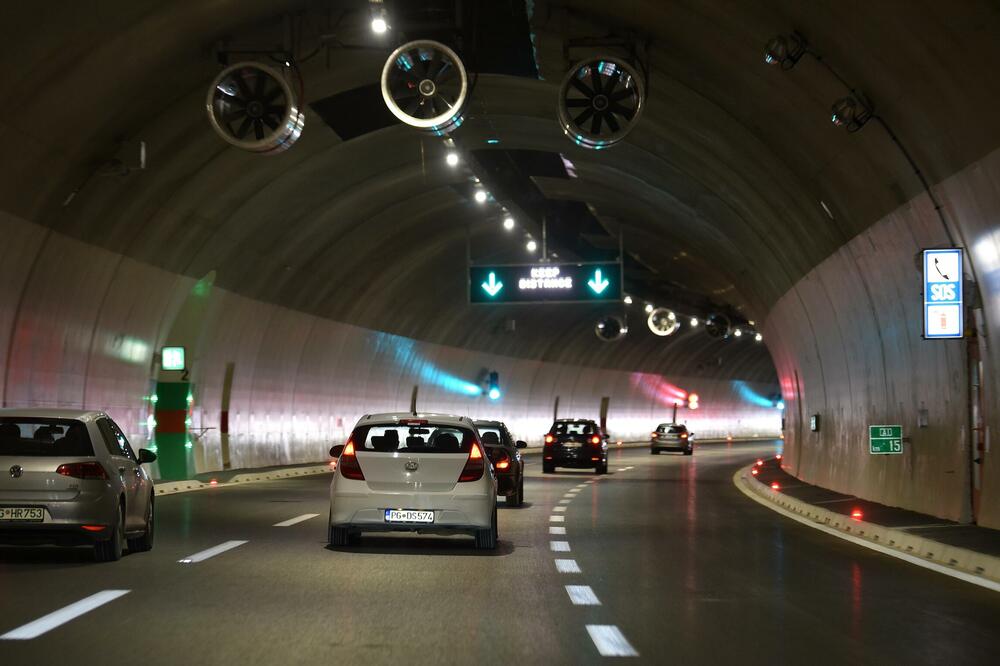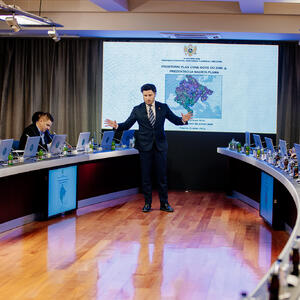By 2040, Montenegro should have two completed highways networked with hundreds of kilometers of expressways along the Montenegrin coast, from Nikšić to Sarajevo, from Bijelo Polje to Pljevlje and further to Goražde, from Beran and Rožaj to Peć...
The two international airports Podgorica and Tivat should have doubled capacity, and five small airports in Podgorica ("Špiro Mugoša"), Nikšić, Berane, Ulcinj and Žabljak will be equipped for sports aviation, as well as smaller planes for tourist and excursion flights.
The thermal power plant should be reconstructed and environmentally acceptable to build three gas power plants in Bar, Podgorica and Pljevlja, ten large solar power plants, as well as four new large wind farms.
The construction of the Kruševo and Komarnica hydroelectric power plants is still planned, but with the caveat that it should be confirmed by environmental impact assessments because "it is necessary to find a compromise between energy development and nature protection".
All landfills for waste disposal will be abolished and Montenegro will be covered by sanitary landfills and recycling centers.
In tourism, the number of beds in five-star hotels should be tripled, in the north there should be ten thousand new beds in higher-class hotels and new specialized mountain camps and resorts.
These are just some of the projections presented in the Draft Spatial Plan of Montenegro published yesterday, which was adopted by the Government and sent to a public hearing that will last for the next 30 days. Yesterday's presentation of the plan at the Government session was also attended by its authors.
The spatial plan defines the purpose of the space and determines the goals of the state's development, and the state parliament makes the final decision in it. It is considered that the spatial plan is the most important act after the Constitution. It is elaborated in more detail by lower-order plans.
The current PPCG expired at the end of 2020. The basic text of the Decision on the preparation of this document is intended to be done within a year from the appointment of the plan manager, and that deadline expired on August 6, 2021. The work is not finished, so the deadline for construction has been extended several times, and with the latest government amendment from December, the deadline for construction was defined for October 1 of this year.

"I hope and believe that the Spatial Plan will be adopted by the Assembly by then. We have given such a broad time frame that, unlike the previous governments, they would not move it every few months", announced the Minister of Ecology, Spatial Planning and Urbanism Ana Novaković Đurović in December last year.

Her department did not finish the work, they only got to the draft.
There is a bridge across the bay, but UNESCO will wait
The spatial plan also left some open dilemmas, one of those examples is the expressway along the coast that should go around the centers of those cities, shorten the distance between them and reduce traffic jams. This document does not offer a final solution as to how the cities will be bypassed, nor where and how this road will cross the Bay of Kotor.
"When it comes to the key issue of the conflict between the traffic solution and the protection of cultural heritage, all analyzes have shown that the 'bridge solution' of the road at the entrance to the Bay of Kotor is a more optimal solution compared to a tunnel solution at the same location, which would have a smaller negative visual effect to a protected area. On the other hand, the UNESCO Report from 2018 on the impact of the expressway corridor on the area of the Bay of Kotor pointed out that the bridge solution should finally be abandoned," the document states.
The bridge near Verigo is still listed as one of the options, but also for which there are negative opinions. For this reason, the drafters of the plan propose that the relevant ministries intensify communication with UNESCO and consider the additional preparation of an assessment of the impact on heritage that would include solutions for crossing the Bay of Kotor.
They said that during the process of public discussion on the draft plan, they will "accept the positions of the Government and its institutions, as well as the final position of the Administration for the Protection of Cultural Properties and UNESCO representatives."
The second option mentioned in the plan is to continue this high-speed road from Tivat via Luštica and cross over to the Herzegovina side near Kumbor. However, the authors of the plan also state that in the development of spatial and urban plans for Herceg Novi, Tivat and Kotor, a corridor of high-speed traffic in the area of Boka was considered and that it was proposed to abandon the consideration of the variant in which the corridor would pass through the area of Luštica.
Expressway around the cities on the coast
The expressway would go in the other direction around Budva, Bar and Ulcinj and go to Albania via the bridge over Bojana.
For the traffic jams through Budva, a solution is planned to build a new road from Markovići, on the road Cetinje - Budva, which would go down around Budva and intersect with the new boulevard that is being built from Jaz to Tivat.

The plan envisages the construction of the full profile of the highway Bar - Boljare, although the feasibility study left the possibility of building it from Beran to Serbia as a semi-highway or expressway.
It is also noted that it will not be possible to build a highway from Podgorica to Bar through the territory of the Skadar Lake National Park, which is why a longer and more expensive variant is proposed that would go over the bridge over Rijeka Crnojevića and completely bypass the protected areas.
The route for the Adriatic-Ionian highway
For the Adriatic-Ian route of the highway, which is a continuation of the highway from Croatia and which has so far reached Čapljina in Bosnia and Herzegovina, from where it should continue through Herzegovina to Montenegro, and then to Albania and Greece. The spatial plan envisages for this highway through Montenegro the route Nudo - Grahovo - Čevo - Podgorica, (bypass), to the border with Albania. This highway would intersect with the Bar - Boljare highway near Farmak. From there, you could continue on the highway towards Bar, and you would go north on the bypass around Podgorica to Smokovac, from where the new branch of the highway would go towards Tuzi and Albania.
In the case of railway transport, it is proposed to continue the reconstruction and invest in the modernization of the railway, but also to better connect this form of transport with the port and road transport.
Railway to Pljevlja, Čapljina, Peć...
It is also stated that it is necessary to "apply for the expansion of the regional transport network for the railway Nikšić - Podgorica, in parallel with the construction activities Nikšić - Trebinje - Čapljina".
The reconstruction and electrification of the Podgorica - Tuzi - Albania railway line is also proposed. Space has also been left for the design of the Pljevlja - Bijelo Polje - Berane - Peć line, for which it is stated that a justification study and conceptual solution have been completed, as well as that the construction of an intermodal terminal in Berane has been proposed.
In the field of energy, the construction of several new transmission lines is foreseen to enable the connection of the planned new solar and wind power plants, as well as the construction of another energy cable for Italy.
For the country to be developed and sustainable
Prime Minister Dritan Abazovic yesterday at the Government session, he said that the plan should provide general guidelines for the future development of the country, and that the most important focus is on the development of transport infrastructure and energy.
According to him, the construction of two highways and the expansion of additional roads will enable every part of the country to be maximally connected.
Abazović pointed out that a bridge will not be built on Veriga, which could cause major problems regarding the UNESCO status of Boka Kotorska.
He also stated that water transport will be improved.
"The main goal is the connection of the Port of Bar with Italy. The spatial plan does not limit the new lines that will be introduced, whether they will be ferry lines, international traffic..." said the Prime Minister.
Speaking about energy, he said that the goal is to become an energy independent country by 2030. He announced that the doubling of the underwater cable that goes to Italy is planned, as well as the construction of wind and solar power plants throughout the country.
Minister of Ecology, Spatial Planning and Urbanism Ana Novaković Đurović she said that the spatial plan is the most important strategic plan in the planning system that determines the goals of spatial development.
"The government managed to bring the document to the draft stage, to shape it 80 percent. The government made it possible for Montenegro to receive a spatial plan until the year 2040 by the end of the year," said Novaković Đurović.
She stated that more than 30 experts participated in the development of the plan, of which 20 were PhDs, as well as representatives of all municipalities.
Novaković Đurović emphasized that the document envisages intensive development of the northern region, as well as that there is a special emphasis on the segment of waste management.
"It is foreseen that there will be landfills and recycling centers in every municipality, which will be regulated in more detail by the state plan on waste management," said Novaković Đurović.
She said that the feature of the planning document is that the need to respect ecological principles is emphasized to the greatest extent.
"The document also foresees restrictions in the part of construction in order to protect the space in relation to decades of devastation," said Novaković Đurović.
Aggravating circumstance because they did not have data from the census
Svetlana Jovanović, head of the development of the spatial plan until 2040, said that the goal of the document is to achieve complementary development.
"And that all sectoral development policies can develop in a complementary way and find a balance when it comes to the development of infrastructure and the protection of space," said Jovanović.
She said that the plan emphasized the population, which, as she stated, is the key capital of the state, but that they had a problem because, due to the postponement of the census in the previous two years, they did not have recent data on the number of inhabitants, households and apartments, which made their work difficult.
"Based on data from the previous census and demographic trends, we made forecasts of the current population. The aim of this plan is to improve the quality of life in the north by building the necessary infrastructure. A lot of investment needs to be made in order to stop negative trends and turn to positive ones in the next ten to 15 years. With development, we must become the retention of people in the north", said Jovanović.
She said that the planning goal is investment in human capital.
"We gave a series of recommendations on how we could have a targeted effect on stopping negative trends and development in the north," said Jovanović.
The plan itself shows that the population in the north will continue to decrease from the current 177 to 158 in 2040, while in the central region it will increase from 293 to 338, and in the coastal region from 148 to 171.
According to her, an important aspect is the reduction of the risk of natural and technical-technological disasters that Montenegro may be exposed to, such as earthquakes.
"The goal is to create comprehensive resilience of the state to respond to such situations. "We are not yet at an adequate level of readiness to be able to say that we are resistant to seismic risk," said Jovanović.
Necessary urgent expansion of airports in Tivat and Podgorica
"In order to raise the quality of services in the field of air transport, it is necessary to expand the space and improve the capacity of international airports Podgorica and Tivat, in order to respond to future needs and standards in this area. This requires the provision of standards that are defined in air traffic in EU countries. The improvement should be reflected in a more diverse offer of passenger and goods transportation and the provision of all operational features that guarantee comfort, safety and speed in traffic," the document states.
For Tivat Airport, it is written that in the coming period, significant infrastructural development will take place, in accordance with the prepared planning documentation and conceptual solution, while for Podgorica Airport, they state that it is necessary to adopt an appropriate planning document as soon as possible in order to create formal assumptions for its further development.
Four years ago, the government launched an international tender for the long-term lease of these two airports, in which the lessee should invest over 150 million euros. The process was stopped for the first time in 2020, due to the pandemic, and the two subsequent governments did not make decisions on whether this procedure with the selection of registered investors would be continued or interrupted.
The plan envisages the possibility of activating the former Kapino Polje airports near Nikšić, Špiro Mugoša near Podgorica, Beran, as well as the runways that were once in operation near Ulcinj and Žabljak. That is why the plan prohibits construction in the zones of these airports and creates assumptions that lower-order plans plan their expansion and modernization in order to develop sports aviation and receive smaller planes, as well as the possibility of bases for firefighting planes.
Bonus video:





